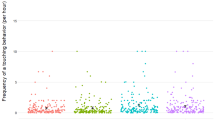Abstract
Gender differences in touch in U.S. populations have been well demonstrated. The age of participants and the setting in which touch occurs have been shown to affect the gender differences. Some investigators have concluded that a gender asymmetry exists with men touching women more than women touch men. A number of studies have shown that men and women interpret touch differently. Past research has provided little information about the effect of the relationship between a couple and the meaning of their touch. In the present study touch initiation among couples was observed in a variety of public settings and then the couples were asked to identify their relationship. It was found that men were more likely to initiate touch during courtship and women were more likely to initiate touch after marriage. A sex difference in reproductive strategies was suggested as one explanation for the phenomenon.
Similar content being viewed by others
References
Beier, E.G. (1974, October). Nonverbal communication: How we send emotional messages.Psychology Today, pp. 52–59.
Beier, E. G., & Sternberg, D. P. (1977). Marital communication: Subtle cues between newlyweds.Journal of Communication, 27, 92–103.
Forden, C. (1981). The influence of sex-role expectations on the perception of touch.Sex Roles, 7, 889–894.
Fisher, J.C., Rytting, M., & Heslin, R. (1976). Hands touching hands: Affective and evaluative effect of interpersonal touch.Sociometry, 39, 416–421.
Goffman, E. (1956). The nature of deference and demeanor.American Anthropologist, 58, 473–502.
Goffman, E. (1971).Relations in public. New York: Harper & Row.
Hall, J.A. (1984).Nonverbal sex differences: Communication accuracy and expressive style. Baltimore, MD: Johns Hopkins University Press.
Hall, J. A. (1987). On explaining gender differences: The case of nonverbal communication.Review of Personality and Social Psychology, 7, 177–200.
Hall, J. A., & Veccia, E. M. (1990). More “touching” observations: New insights on men, women, and interpersonal touch.Journal of Personality and Social Psychology, 59, 1155–1162.
Henley, N.M. (1973). Status and sex: Some touching observations.Bulletin of the Psychonomic Society, 2, 91–93.
Henley, N.M. (1977).Body Politics: Power, sex, and nonverbal communication. Englewood Cliffs, NJ: Prentice-Hall.
Heslin, R., & Boss, D. (1980). Nonverbal intimacy in airport arrival and departure.Personality and Social Psychology Bulletin, 6, 248–252.
Hollander, M. H., Luborsky, L., & Scaramella, T. J. (1969). Body contact and sexual enticement.Archives of General Psychiatry, 20, 188–191.
Johnson, K. L., & Edwards, R. (1991). The effects of gender and type of romantic touch on perceptions of relational commitment.Journal of Nonverbal Behavior, 15, 43–55.
Jourard, S.M. (1968).Disclosing man to himself. New York: Van Nostrand Reinhold.
Major, B. (1981). Gender patterns in touching behavior. In C. Mayo & N. M. Henley (Eds.),Gender and nonverbal behavior (pp. 15–37). New York: Springer-Verlag.
Major, B., & Heslin, R. (1982). Perceptions of cross-sex and same-sex nonreciprocal touch: It is better to give than to receive.Journal of Nonverbal Behavior, 6, 148–162.
Major, B., Schmidlin, A.M., & Williams, L. (1990). Gender patterns in social touch: The impact of setting and age.Journal of Personality and Social Psychology, 58, 634–643.
Nguyen, T., Heslin, R., & Nguyen, M. L. (1975). The meanings of touch: Sex differences.Journal of Communication, 25, 92–103.
Nguyen, T., Heslin, R., & Nguyen, M. L. (1976). The meanings of touch: Sex and marital status differences.Representative Research in Social Psychology, 7, 13–18.
Pisano, M. D., Wall, S. M., & Foster, A. (1986). Perceptions of nonreciprocal touch in romantic relationships.Journal of Nonverbal Behavior, 10, 29–39.
Richmond, V.P., McCroskey, J.C., & Payne, S.K. (1991).Nonverbal behavior in interpersonal relations. Englewood Cliffs, NJ: Prentice-Hall.
Silverthorne, C., Micklewright, J., O'Donnell, M., & Gibson, R. (1976). Attribution of personal characteristics as a function of the degree of touch on initial contact and sex.Sex Roles, 2, 185–193.
Stier, D.S., & Hall, J.A. (1984). Gender differences in touch: An empirical and theoretical review.Journal of Personality and Social Psychology, 42, 440–459.
Storrs, D., & Kleinke, C. L. (1990). Evaluations of high and equal status male and female touchers.Journal of Nonverbal Behavior, 114, 87–95.
Summerhayes, D. L., & Suchner, R. W. (1978). Power implications of touch in male-female relationships.Sex Roles, 4, 103–110.
Sussman, N.M., & Rosenfeld, H. M. (1978). Touch, justification, and sex: Influences on the aversiveness of spatial violation.Journal of Social Psychology, 106, 215–225.
Whitcher, S. J., & Fisher, J. D. (1979). Multidimensional reaction to therapeutic touch in a hospital setting.Journal of Personality and Social Psychology, 37, 87–96.
White, G. T. (1975).The mating game: Nonverbal interpersonal communication between dating and engaged college couples. Paper presented at the meeting of the Western Psychological Association, Sacramento, CA.
Willis, F.N., & Rinck, C.M. (1983). A personal log method for investigating interpersonal touch.Journal of Psychology, 113, 119–122.
Author information
Authors and Affiliations
Rights and permissions
About this article
Cite this article
Willis, F.N., Briggs, L.F. Relationship and touch in public settings. J Nonverbal Behav 16, 55–63 (1992). https://doi.org/10.1007/BF00986879
Issue Date:
DOI: https://doi.org/10.1007/BF00986879




